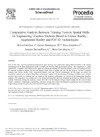Identificador persistente para citar o vincular este elemento:
https://accedacris.ulpgc.es/jspui/handle/10553/46425
| Campo DC | Valor | idioma |
|---|---|---|
| dc.contributor.author | Martín-Gutiérrez, J. | en_US |
| dc.contributor.author | García-Domínguez, M. | en_US |
| dc.contributor.author | Roca-González, C. | en_US |
| dc.contributor.author | Sanjuán Hernán-Pérez, Alejandra | en_US |
| dc.contributor.author | Mato Carrodeguas, María del Carmen | en_US |
| dc.date.accessioned | 2018-11-23T04:31:34Z | - |
| dc.date.available | 2018-11-23T04:31:34Z | - |
| dc.date.issued | 2013 | en_US |
| dc.identifier.issn | 1877-0509 | en_US |
| dc.identifier.other | WoS | - |
| dc.identifier.uri | https://accedacris.ulpgc.es/handle/10553/46425 | - |
| dc.description.abstract | One of the skills that all engineering professional must develop very extensively during their formation is the mental management of the three dimensional reality in which they develop their professional actions. This competence is called spatial skill, a cognitive skill which can be improved with proper training. We have developed a series of learning activities for students in order to acquire, develop and improve their levels of spatial skill and, for this purpose; we have structured training with Virtual Reality (VR), Augmented Reality (AR) and PDF3D technologies. In this paper we collect the experience carried out to compare these three technologies together with the intention of finding out which one(s) of them provides best results as a training tool and improved the academic performance of students in the Engineering Graphics subjects. The experience was carried out at the School of Industrial and Civil Engineering of the Las Palmas de Gran Canaria University, during the academic course 2012/2013 on the Graphic Design subject during the first year of these degrees: Industrial Technologies Engineering, Industrial Design and Product Development Engineering, Naval Technology Engineering, Chemical Engineering and Industrial Management Engineering. | en_US |
| dc.language | eng | en_US |
| dc.relation.ispartof | Procedia Computer Science | en_US |
| dc.source | Procedia Computer Science [ISSN 1877-0509] ,v. 25, p. 360-363 | en_US |
| dc.subject | 250508 Geografía topográfica | en_US |
| dc.subject | 580203 Desarrollo de asignaturas | en_US |
| dc.subject.other | Virtual Reality | en_US |
| dc.subject.other | Augmented Reality | en_US |
| dc.subject.other | PDF3D | en_US |
| dc.subject.other | Spatial Skills | en_US |
| dc.subject.other | Rate of Return | en_US |
| dc.subject.other | Success Rate | en_US |
| dc.title | Comparative analysis between training tools in spatial skills for engineering graphics students based in virtual reality, augmented reality and PDF3D technologies | en_US |
| dc.type | info:eu-repo/semantics/conferenceObject | en_US |
| dc.relation.conference | International Conference on Virtual and Augmented Reality in Education (VARE) | en_US |
| dc.identifier.doi | 10.1016/j.procs.2013.11.043 | en_US |
| dc.identifier.scopus | 84890686536 | - |
| dc.identifier.isi | 000345445900042 | - |
| dc.contributor.authorscopusid | 57211089549 | - |
| dc.contributor.authorscopusid | 57201412982 | - |
| dc.contributor.authorscopusid | 55971033000 | - |
| dc.contributor.authorscopusid | 55853726300 | - |
| dc.contributor.authorscopusid | 55970121600 | - |
| dc.contributor.authorscopusid | 55970176600 | - |
| dc.description.lastpage | 363 | en_US |
| dc.description.firstpage | 360 | en_US |
| dc.relation.volume | 25 | en_US |
| dc.investigacion | Ingeniería y Arquitectura | en_US |
| dc.type2 | Artículo | en_US |
| dc.contributor.daisngid | 1075402 | - |
| dc.contributor.daisngid | 6988545 | - |
| dc.contributor.daisngid | 7330228 | - |
| dc.contributor.daisngid | 9898030 | - |
| dc.contributor.daisngid | 17309756 | - |
| dc.description.observaciones | Edited by Jorge Martin-Gutierrez, Egils Ginters | en_US |
| dc.description.numberofpages | 4 | en_US |
| dc.utils.revision | Sí | en_US |
| dc.contributor.wosstandard | WOS:Martin-Gutierrez, J | - |
| dc.contributor.wosstandard | WOS:Garcia-Dominguez, M | - |
| dc.contributor.wosstandard | WOS:Roca-Gonzalez, C | - |
| dc.contributor.wosstandard | WOS:Sanjuan-HernanPerez, A | - |
| dc.contributor.wosstandard | WOS:Mato-Carrodeguas, C | - |
| dc.date.coverdate | Enero 2013 | en_US |
| dc.identifier.conferenceid | events120882 | - |
| dc.identifier.ulpgc | Sí | es |
| item.grantfulltext | open | - |
| item.fulltext | Con texto completo | - |
| crisitem.event.eventsstartdate | 07-11-2013 | - |
| crisitem.event.eventsenddate | 09-11-2013 | - |
| crisitem.author.dept | Departamento de Cartografía y Expresión Gráfica en La Ingeniería | - |
| crisitem.author.dept | GIR IDeTIC: División de Fotónica y Comunicaciones | - |
| crisitem.author.dept | IU para el Desarrollo Tecnológico y la Innovación | - |
| crisitem.author.dept | Departamento de Cartografía y Expresión Gráfica en La Ingeniería | - |
| crisitem.author.dept | GIR IUNAT: Biología Integrativa y Recursos Biológicos | - |
| crisitem.author.dept | IU de Estudios Ambientales y Recursos Naturales | - |
| crisitem.author.orcid | 0000-0002-8557-645X | - |
| crisitem.author.orcid | 0009-0002-2986-768X | - |
| crisitem.author.orcid | 0000-0002-0992-1178 | - |
| crisitem.author.parentorg | IU para el Desarrollo Tecnológico y la Innovación | - |
| crisitem.author.parentorg | IU de Estudios Ambientales y Recursos Naturales | - |
| crisitem.author.fullName | García Domínguez, Melchor | - |
| crisitem.author.fullName | Roca González, María Cristina | - |
| crisitem.author.fullName | Sanjuán Hernán-Pérez, Alejandra | - |
| crisitem.author.fullName | Mato Carrodeguas,Maria Del Carmen | - |
| Colección: | Actas de congresos | |
Vista resumida
Los elementos en ULPGC accedaCRIS están protegidos por derechos de autor con todos los derechos reservados, a menos que se indique lo contrario.
